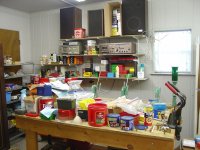If the brass is once fired from rifle(s) other than your own, would suggest a small base die. At least for the first sizing. Especially if the brass your using is actually bulk brass from military firing range.
Would also consider a dedicated primer pocket swager for that many cases. The RCBS primer swager die works, but is extremely slow and takes some effort.
Not to forget a powered trimmer.
And if at all within budget, would consider a comp seating die. Preferable a Redding with Forster a fairly close second and much more affordable.
5000 rounds is a considerable effort, especially with brass from unknown rifles/full auto's. And alot depends on what you want out of your rounds. Components are very expensive to just making blaster rounds anymore.
I tried several different brands of seating dues before settling on the Forster Benchrest Seater. It is a "better mousetrap" in that there's a sliding sleeve inside to hold the case in perfect alignment for seating. Redding uses Forster's patent now that it's expired and costs more, but I've had very good success with Redding dies also.
For me, a single stage press makes more sense for bottle necked rifle cartridges. I de-prime and full length size, then need to remove the case lube (Redding Imperial Sizing Wax) and inspect the cases. Then I set up a set of tools to 1) measure case to see if it needs trimming, 2) trim if necessary, 3) chamfer and debug case mouth if trimmed, 4) clean primer pocket, 5) lube inside of neck with graphite on brush, and 6) prime on bench mounted Forster Co-Ax priming tool (not necessary for .223 but helpful for larger rifle cartridges).
First time only - I also use a flash hole deburring tool, whether it's new or once-fired brass.
A Wilson case gauge will tell you if the headspace is within spec and if the case is beyond max length; however, it does not check the outside diameter of the case body or case neck. (I did not realize that for years although it's right there in the instructions.) I have not bought one yet, but Sheridan makes a very nice case gauge that
does check the whole case and is available with a cutout so you can see where your problem is.
Apparently crimping bottlenecked rifle cartridges is a thing now. It wasn't when I started hand loading almost 20 years ago. A few months ago I called both Hornady and Sierra about this figuring that the top bullet manufacturers would know better than anyone else. The Hornady tech said "you can but you don't have to". The Sierra tech said "crimp if there's a cannelure and don't if there isn't." YMMV and everyone has an opinion…
I firmly believe that every hand loader should have a balance beam scale to check whatever electronic gizmo you use. I do love my RCBS ChargeMaster, but the first one I got wouldn't hold zero for more than 20 minutes. Fortunately I caught it and RCBS couldn't have been better about replacing the damned thing. CHECK WEIGHTS! Always use check weights.
About data - I prefer data directly from the bullet manufacturer as my primary source with powder manufacturer as backup. More data sources is better… except YouScrewed.


